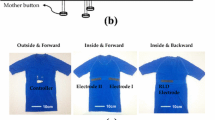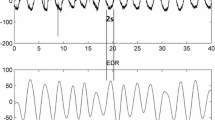Abstract
Respiration monitoring by means of electric field plethysmography is influenced by cardiac activity, which represents an artefact although of physiological relevance itself. For a separation of respiration and cardiac signals, a portable plethysmograph was developed, which uses a fifth electrode in addition to the conventional tetrapolar electrode arrangement. The separation is attained by weighted software subtraction of two detected signals. In a comparative way, three mathematical methods are discussed for the effective determination of individual weighting factors. Results of the practical applications indicate the best results for a method based on Fast Fourier Transformation.
Similar content being viewed by others
References
Eiken, O., andSegerhammer, P. (1988): ‘Elimination of breathing artefacts from impedance cardiograms at rest and during exercise,’Med. Biol. Eng. Comput.,26, pp. 13–16
Furuya, N., andNakayama, K. (1986): ‘Development of multielectrode impedance plethysmography,’Med. Biol. Eng. Comput.,34, pp. 62–70
Futschik, K., Pfützner, H., Harasko, G. Komaromi, P., Schönthaler, M., Frass, M., Frenzer, R., Lackner, F., andIlias, W. (1986): ‘Heart artefacts in electrical field plethysmography of the lung.’ Jahrestagung der Österreichischen Gesellschaft für Biomedizinische Technik, Baden, Medizin-Technik/Medizin-Informatik 86, Oldenbourg-Verlag (in German)
Guha, S. K., Tandon, S. N., andKhan, M. R. (1974): ‘Electical field plethysmography,’Biomed. Eng.,9, pp. 510–514
Guha, S. K., andAnandand, S. (1981): ‘Cardiac output by field plethysmography.’ Proc. Vth ICEBI, Tokyo, Japan, pp. 53–56
Lozano, A., Rosell, J., andPallas-Areny, R. (1990): ‘Two-frequency impedance plethysmograph: real and imaginary parts,’Biomed. Eng.,28, pp. 38–42
Nakamura, T., Miyamoto, Y., Sakakibara, K., Tamura, T., Takahashi, M., Hiura, T., andMikami, T. (1981): ‘Breath-by-breath graphical display of cardiorespiratory function.’ Proc. Vth ICEBI, Tokyo, Japan, pp. 345–348
Nopp, P., Rapp, E., Pfützner, H., Nakesch, H., andRuhsam, Ch. (1993): ‘Dielectric properties of lung tissue as a function of air content,’Phys. Med. Biol.,38, pp. 699–716
Pfützner, H., Futschik, K., Doblander, A., Schenz, G., andZwick, H. (1990): ‘A method for the elimination of artefacts in electric field plethysmography of the lung,’Front. Med. Biol. Eng.,2, (1), pp. 53–63
Ragheb, A. O., Geddes, L. A., Bourland, J. D., andTacker, W. A. (1992): ‘Tetrapolar electrode system for measuring physiological events by impedance,’Med. Biol. Eng. Comput.,30, pp. 115–117
Ruhsam, Ch., Pfützner, H., Nopp, P., Nakesch, H., Frais-Kölbl, H., andMarktl, W. (1994): ‘Time-frequency spectral analysis of electric field plethysmography signals’,Med. Prog. Tech.
Sahakian, A. V., Tompkins, W. J., andWebster, J. G. (1985): ‘Electrode motion artifacts in electical impedance pneumography,’IEEE Trans.,BME-32, pp. 448–451
Spector, W. S. (1956): ‘Handbook of biological data’ (W. B. Saunders, Philadelphia) p. 267
Author information
Authors and Affiliations
Rights and permissions
About this article
Cite this article
Nakesch, H., Pfützner, H., Ruhsam, C. et al. Five-electrode field plethysmography technique for separation of respiration and cardiac signals. Med. Biol. Eng. Comput. 32 (Suppl 1), S65–S70 (1994). https://doi.org/10.1007/BF02523330
Received:
Accepted:
Issue Date:
DOI: https://doi.org/10.1007/BF02523330




